The Importance of Mandarin Language Education
VerifiedAdded on 2021/04/17
|13
|3480
|41
AI Summary
This assignment discusses the importance of mandarin language education, highlighting its benefits for students who take up mandarin as a second language. The document also emphasizes the need to provide career opportunities and financial aids to needy students who want to study mandarin. Furthermore, it stresses the significance of creating facilities for further research and development of the language worldwide.
Contribute Materials
Your contribution can guide someone’s learning journey. Share your
documents today.

Running note- MANDARIN LANGUAGE
MANDARIN LANGUAGE
Name of student
Name of university
Author note
MANDARIN LANGUAGE
Name of student
Name of university
Author note
Secure Best Marks with AI Grader
Need help grading? Try our AI Grader for instant feedback on your assignments.
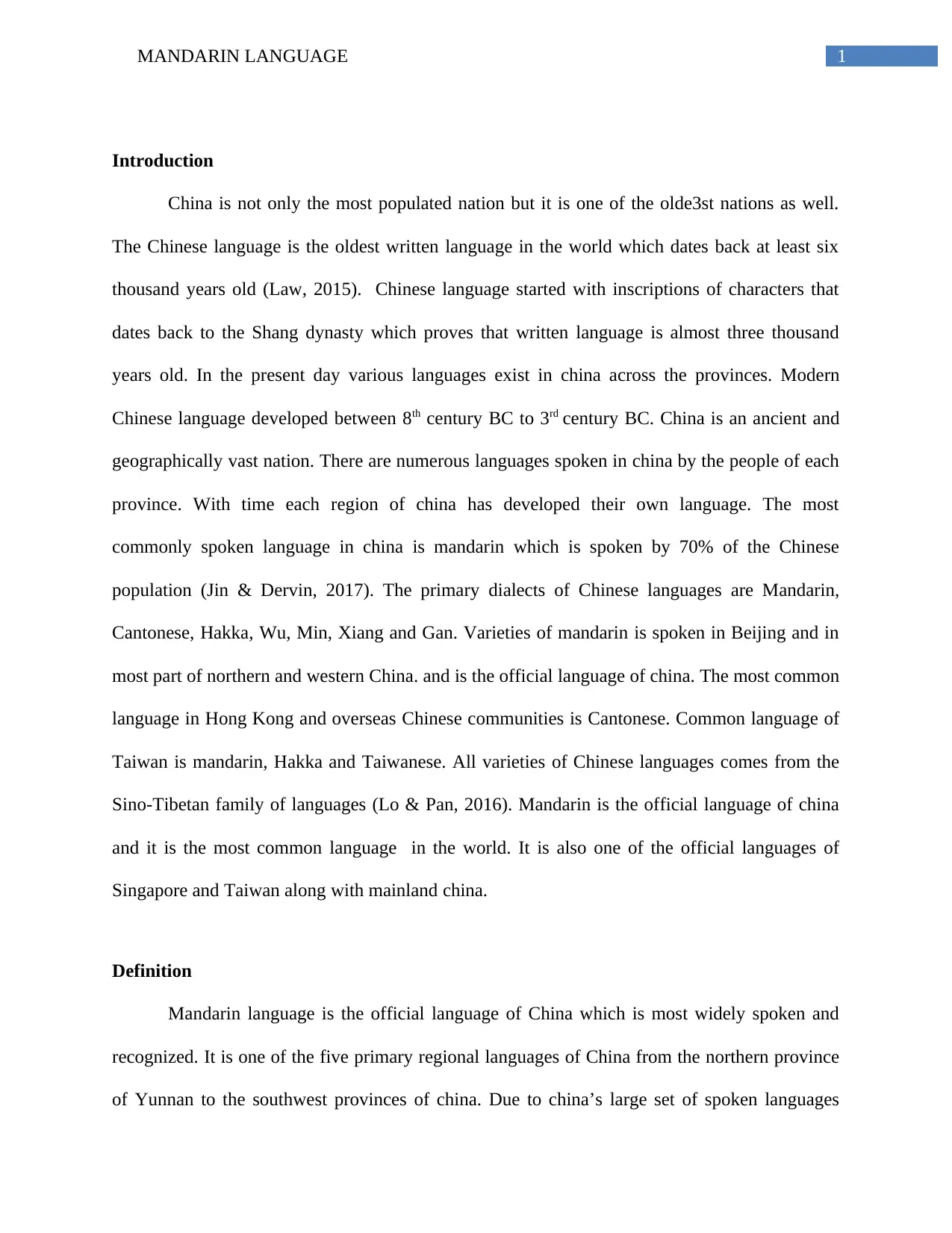
1MANDARIN LANGUAGE
Introduction
China is not only the most populated nation but it is one of the olde3st nations as well.
The Chinese language is the oldest written language in the world which dates back at least six
thousand years old (Law, 2015). Chinese language started with inscriptions of characters that
dates back to the Shang dynasty which proves that written language is almost three thousand
years old. In the present day various languages exist in china across the provinces. Modern
Chinese language developed between 8th century BC to 3rd century BC. China is an ancient and
geographically vast nation. There are numerous languages spoken in china by the people of each
province. With time each region of china has developed their own language. The most
commonly spoken language in china is mandarin which is spoken by 70% of the Chinese
population (Jin & Dervin, 2017). The primary dialects of Chinese languages are Mandarin,
Cantonese, Hakka, Wu, Min, Xiang and Gan. Varieties of mandarin is spoken in Beijing and in
most part of northern and western China. and is the official language of china. The most common
language in Hong Kong and overseas Chinese communities is Cantonese. Common language of
Taiwan is mandarin, Hakka and Taiwanese. All varieties of Chinese languages comes from the
Sino-Tibetan family of languages (Lo & Pan, 2016). Mandarin is the official language of china
and it is the most common language in the world. It is also one of the official languages of
Singapore and Taiwan along with mainland china.
Definition
Mandarin language is the official language of China which is most widely spoken and
recognized. It is one of the five primary regional languages of China from the northern province
of Yunnan to the southwest provinces of china. Due to china’s large set of spoken languages
Introduction
China is not only the most populated nation but it is one of the olde3st nations as well.
The Chinese language is the oldest written language in the world which dates back at least six
thousand years old (Law, 2015). Chinese language started with inscriptions of characters that
dates back to the Shang dynasty which proves that written language is almost three thousand
years old. In the present day various languages exist in china across the provinces. Modern
Chinese language developed between 8th century BC to 3rd century BC. China is an ancient and
geographically vast nation. There are numerous languages spoken in china by the people of each
province. With time each region of china has developed their own language. The most
commonly spoken language in china is mandarin which is spoken by 70% of the Chinese
population (Jin & Dervin, 2017). The primary dialects of Chinese languages are Mandarin,
Cantonese, Hakka, Wu, Min, Xiang and Gan. Varieties of mandarin is spoken in Beijing and in
most part of northern and western China. and is the official language of china. The most common
language in Hong Kong and overseas Chinese communities is Cantonese. Common language of
Taiwan is mandarin, Hakka and Taiwanese. All varieties of Chinese languages comes from the
Sino-Tibetan family of languages (Lo & Pan, 2016). Mandarin is the official language of china
and it is the most common language in the world. It is also one of the official languages of
Singapore and Taiwan along with mainland china.
Definition
Mandarin language is the official language of China which is most widely spoken and
recognized. It is one of the five primary regional languages of China from the northern province
of Yunnan to the southwest provinces of china. Due to china’s large set of spoken languages
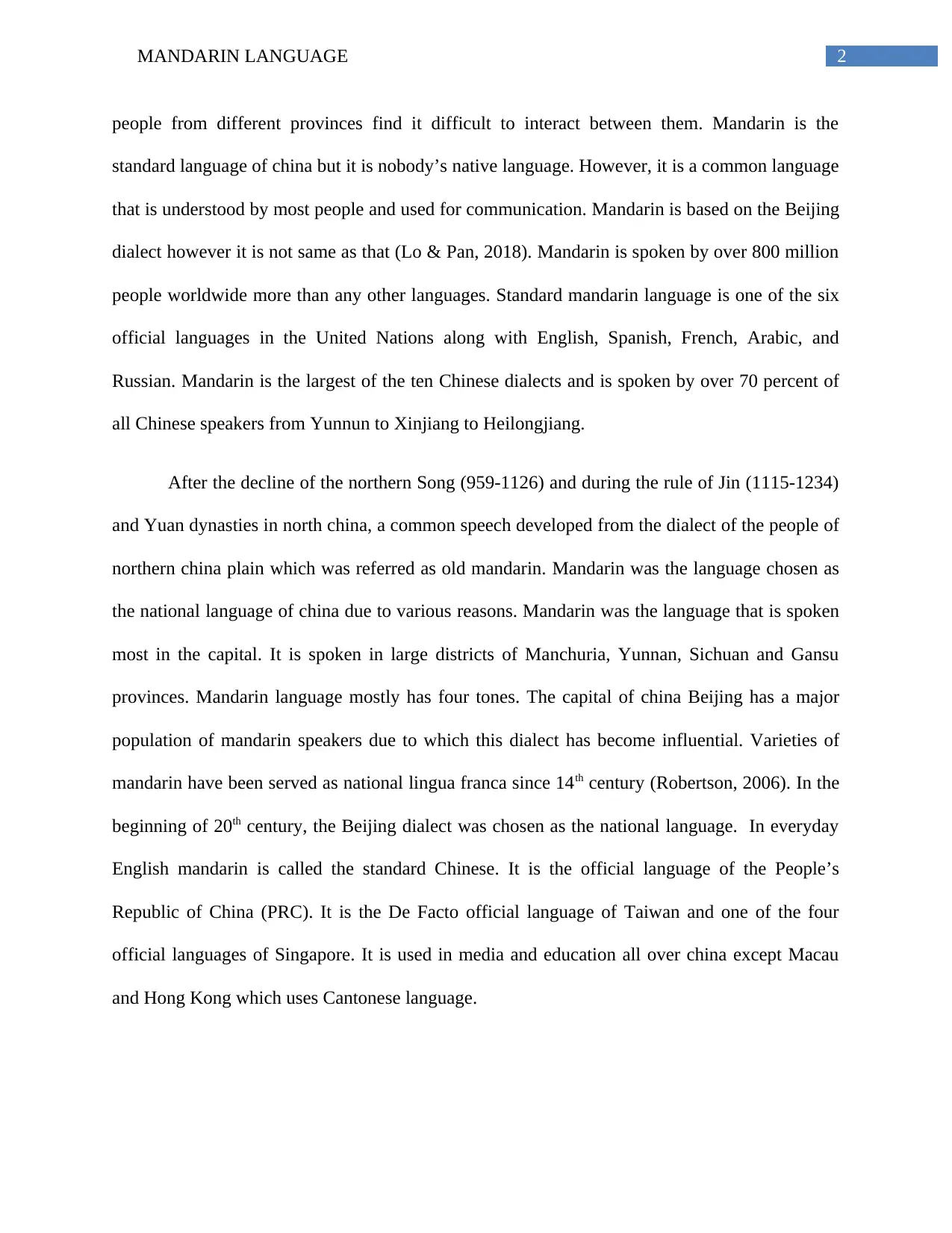
2MANDARIN LANGUAGE
people from different provinces find it difficult to interact between them. Mandarin is the
standard language of china but it is nobody’s native language. However, it is a common language
that is understood by most people and used for communication. Mandarin is based on the Beijing
dialect however it is not same as that (Lo & Pan, 2018). Mandarin is spoken by over 800 million
people worldwide more than any other languages. Standard mandarin language is one of the six
official languages in the United Nations along with English, Spanish, French, Arabic, and
Russian. Mandarin is the largest of the ten Chinese dialects and is spoken by over 70 percent of
all Chinese speakers from Yunnun to Xinjiang to Heilongjiang.
After the decline of the northern Song (959-1126) and during the rule of Jin (1115-1234)
and Yuan dynasties in north china, a common speech developed from the dialect of the people of
northern china plain which was referred as old mandarin. Mandarin was the language chosen as
the national language of china due to various reasons. Mandarin was the language that is spoken
most in the capital. It is spoken in large districts of Manchuria, Yunnan, Sichuan and Gansu
provinces. Mandarin language mostly has four tones. The capital of china Beijing has a major
population of mandarin speakers due to which this dialect has become influential. Varieties of
mandarin have been served as national lingua franca since 14th century (Robertson, 2006). In the
beginning of 20th century, the Beijing dialect was chosen as the national language. In everyday
English mandarin is called the standard Chinese. It is the official language of the People’s
Republic of China (PRC). It is the De Facto official language of Taiwan and one of the four
official languages of Singapore. It is used in media and education all over china except Macau
and Hong Kong which uses Cantonese language.
people from different provinces find it difficult to interact between them. Mandarin is the
standard language of china but it is nobody’s native language. However, it is a common language
that is understood by most people and used for communication. Mandarin is based on the Beijing
dialect however it is not same as that (Lo & Pan, 2018). Mandarin is spoken by over 800 million
people worldwide more than any other languages. Standard mandarin language is one of the six
official languages in the United Nations along with English, Spanish, French, Arabic, and
Russian. Mandarin is the largest of the ten Chinese dialects and is spoken by over 70 percent of
all Chinese speakers from Yunnun to Xinjiang to Heilongjiang.
After the decline of the northern Song (959-1126) and during the rule of Jin (1115-1234)
and Yuan dynasties in north china, a common speech developed from the dialect of the people of
northern china plain which was referred as old mandarin. Mandarin was the language chosen as
the national language of china due to various reasons. Mandarin was the language that is spoken
most in the capital. It is spoken in large districts of Manchuria, Yunnan, Sichuan and Gansu
provinces. Mandarin language mostly has four tones. The capital of china Beijing has a major
population of mandarin speakers due to which this dialect has become influential. Varieties of
mandarin have been served as national lingua franca since 14th century (Robertson, 2006). In the
beginning of 20th century, the Beijing dialect was chosen as the national language. In everyday
English mandarin is called the standard Chinese. It is the official language of the People’s
Republic of China (PRC). It is the De Facto official language of Taiwan and one of the four
official languages of Singapore. It is used in media and education all over china except Macau
and Hong Kong which uses Cantonese language.
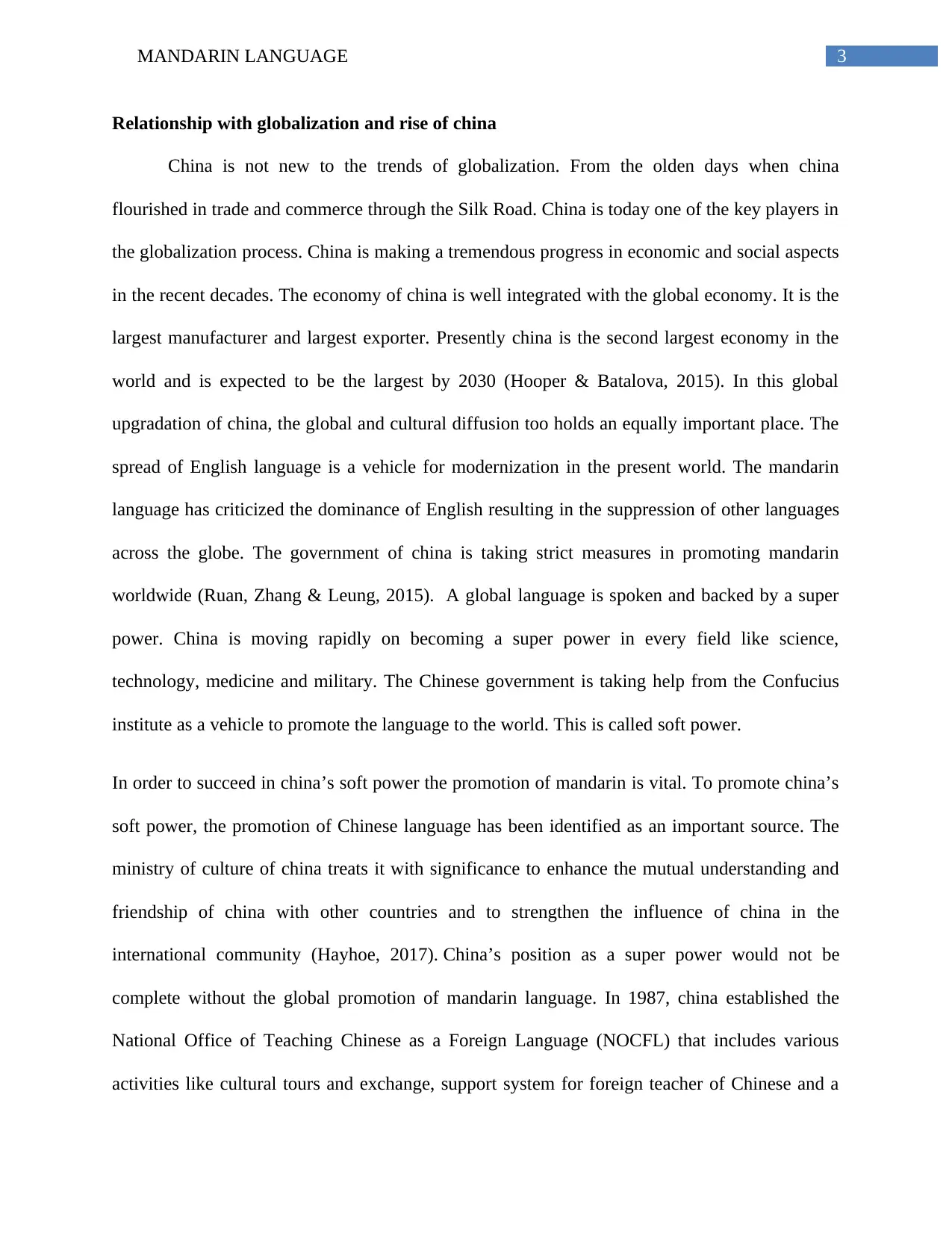
3MANDARIN LANGUAGE
Relationship with globalization and rise of china
China is not new to the trends of globalization. From the olden days when china
flourished in trade and commerce through the Silk Road. China is today one of the key players in
the globalization process. China is making a tremendous progress in economic and social aspects
in the recent decades. The economy of china is well integrated with the global economy. It is the
largest manufacturer and largest exporter. Presently china is the second largest economy in the
world and is expected to be the largest by 2030 (Hooper & Batalova, 2015). In this global
upgradation of china, the global and cultural diffusion too holds an equally important place. The
spread of English language is a vehicle for modernization in the present world. The mandarin
language has criticized the dominance of English resulting in the suppression of other languages
across the globe. The government of china is taking strict measures in promoting mandarin
worldwide (Ruan, Zhang & Leung, 2015). A global language is spoken and backed by a super
power. China is moving rapidly on becoming a super power in every field like science,
technology, medicine and military. The Chinese government is taking help from the Confucius
institute as a vehicle to promote the language to the world. This is called soft power.
In order to succeed in china’s soft power the promotion of mandarin is vital. To promote china’s
soft power, the promotion of Chinese language has been identified as an important source. The
ministry of culture of china treats it with significance to enhance the mutual understanding and
friendship of china with other countries and to strengthen the influence of china in the
international community (Hayhoe, 2017). China’s position as a super power would not be
complete without the global promotion of mandarin language. In 1987, china established the
National Office of Teaching Chinese as a Foreign Language (NOCFL) that includes various
activities like cultural tours and exchange, support system for foreign teacher of Chinese and a
Relationship with globalization and rise of china
China is not new to the trends of globalization. From the olden days when china
flourished in trade and commerce through the Silk Road. China is today one of the key players in
the globalization process. China is making a tremendous progress in economic and social aspects
in the recent decades. The economy of china is well integrated with the global economy. It is the
largest manufacturer and largest exporter. Presently china is the second largest economy in the
world and is expected to be the largest by 2030 (Hooper & Batalova, 2015). In this global
upgradation of china, the global and cultural diffusion too holds an equally important place. The
spread of English language is a vehicle for modernization in the present world. The mandarin
language has criticized the dominance of English resulting in the suppression of other languages
across the globe. The government of china is taking strict measures in promoting mandarin
worldwide (Ruan, Zhang & Leung, 2015). A global language is spoken and backed by a super
power. China is moving rapidly on becoming a super power in every field like science,
technology, medicine and military. The Chinese government is taking help from the Confucius
institute as a vehicle to promote the language to the world. This is called soft power.
In order to succeed in china’s soft power the promotion of mandarin is vital. To promote china’s
soft power, the promotion of Chinese language has been identified as an important source. The
ministry of culture of china treats it with significance to enhance the mutual understanding and
friendship of china with other countries and to strengthen the influence of china in the
international community (Hayhoe, 2017). China’s position as a super power would not be
complete without the global promotion of mandarin language. In 1987, china established the
National Office of Teaching Chinese as a Foreign Language (NOCFL) that includes various
activities like cultural tours and exchange, support system for foreign teacher of Chinese and a
Secure Best Marks with AI Grader
Need help grading? Try our AI Grader for instant feedback on your assignments.
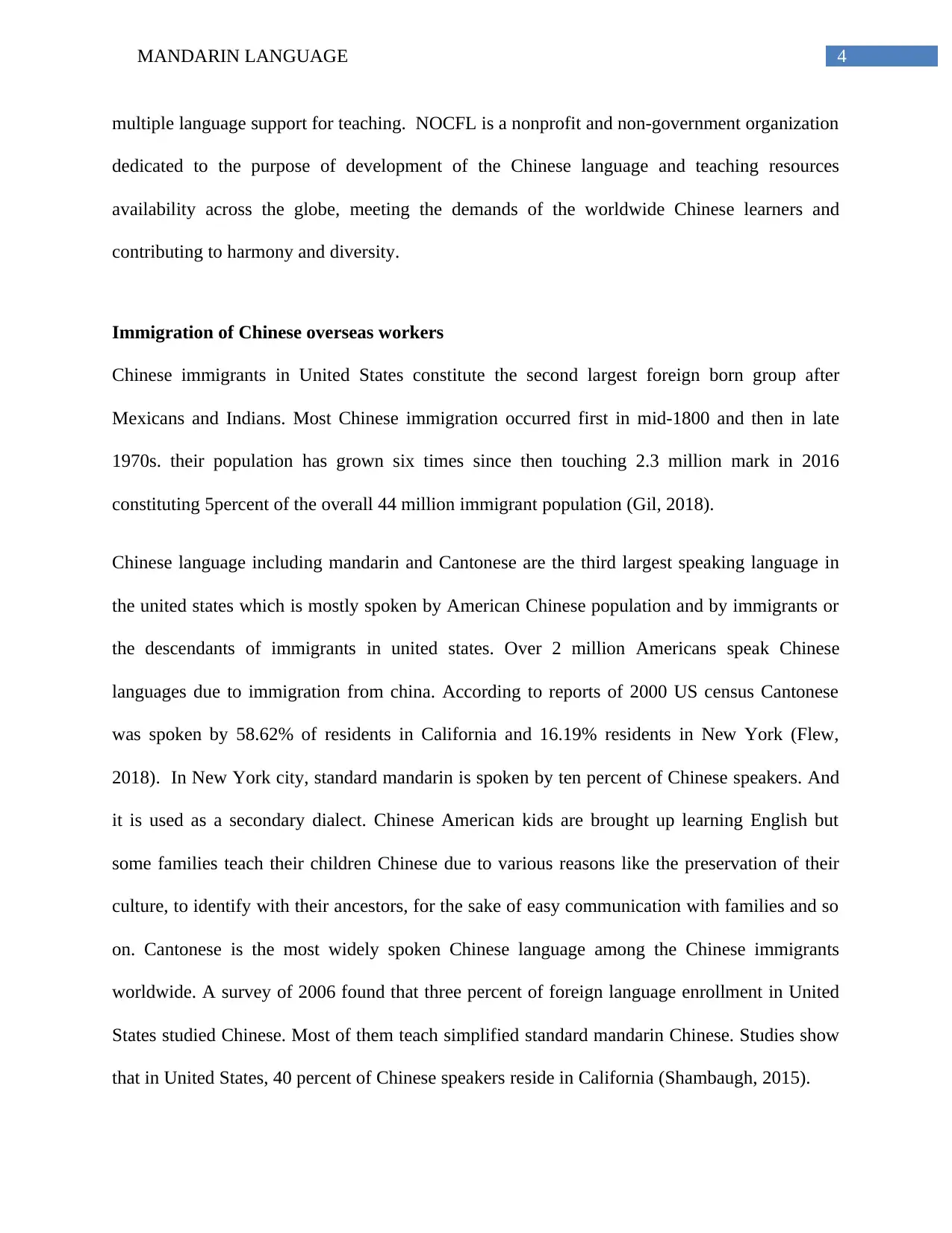
4MANDARIN LANGUAGE
multiple language support for teaching. NOCFL is a nonprofit and non-government organization
dedicated to the purpose of development of the Chinese language and teaching resources
availability across the globe, meeting the demands of the worldwide Chinese learners and
contributing to harmony and diversity.
Immigration of Chinese overseas workers
Chinese immigrants in United States constitute the second largest foreign born group after
Mexicans and Indians. Most Chinese immigration occurred first in mid-1800 and then in late
1970s. their population has grown six times since then touching 2.3 million mark in 2016
constituting 5percent of the overall 44 million immigrant population (Gil, 2018).
Chinese language including mandarin and Cantonese are the third largest speaking language in
the united states which is mostly spoken by American Chinese population and by immigrants or
the descendants of immigrants in united states. Over 2 million Americans speak Chinese
languages due to immigration from china. According to reports of 2000 US census Cantonese
was spoken by 58.62% of residents in California and 16.19% residents in New York (Flew,
2018). In New York city, standard mandarin is spoken by ten percent of Chinese speakers. And
it is used as a secondary dialect. Chinese American kids are brought up learning English but
some families teach their children Chinese due to various reasons like the preservation of their
culture, to identify with their ancestors, for the sake of easy communication with families and so
on. Cantonese is the most widely spoken Chinese language among the Chinese immigrants
worldwide. A survey of 2006 found that three percent of foreign language enrollment in United
States studied Chinese. Most of them teach simplified standard mandarin Chinese. Studies show
that in United States, 40 percent of Chinese speakers reside in California (Shambaugh, 2015).
multiple language support for teaching. NOCFL is a nonprofit and non-government organization
dedicated to the purpose of development of the Chinese language and teaching resources
availability across the globe, meeting the demands of the worldwide Chinese learners and
contributing to harmony and diversity.
Immigration of Chinese overseas workers
Chinese immigrants in United States constitute the second largest foreign born group after
Mexicans and Indians. Most Chinese immigration occurred first in mid-1800 and then in late
1970s. their population has grown six times since then touching 2.3 million mark in 2016
constituting 5percent of the overall 44 million immigrant population (Gil, 2018).
Chinese language including mandarin and Cantonese are the third largest speaking language in
the united states which is mostly spoken by American Chinese population and by immigrants or
the descendants of immigrants in united states. Over 2 million Americans speak Chinese
languages due to immigration from china. According to reports of 2000 US census Cantonese
was spoken by 58.62% of residents in California and 16.19% residents in New York (Flew,
2018). In New York city, standard mandarin is spoken by ten percent of Chinese speakers. And
it is used as a secondary dialect. Chinese American kids are brought up learning English but
some families teach their children Chinese due to various reasons like the preservation of their
culture, to identify with their ancestors, for the sake of easy communication with families and so
on. Cantonese is the most widely spoken Chinese language among the Chinese immigrants
worldwide. A survey of 2006 found that three percent of foreign language enrollment in United
States studied Chinese. Most of them teach simplified standard mandarin Chinese. Studies show
that in United States, 40 percent of Chinese speakers reside in California (Shambaugh, 2015).
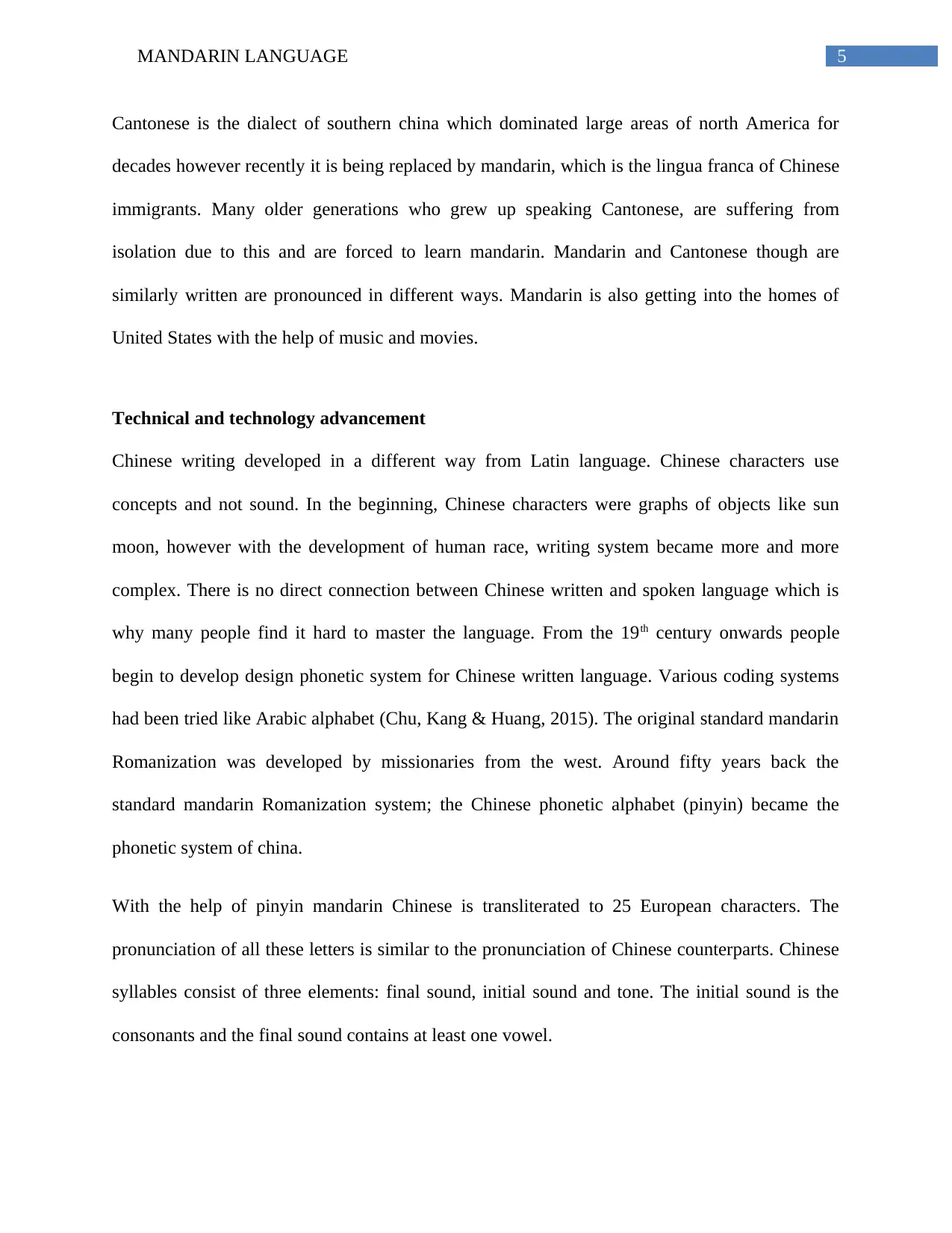
5MANDARIN LANGUAGE
Cantonese is the dialect of southern china which dominated large areas of north America for
decades however recently it is being replaced by mandarin, which is the lingua franca of Chinese
immigrants. Many older generations who grew up speaking Cantonese, are suffering from
isolation due to this and are forced to learn mandarin. Mandarin and Cantonese though are
similarly written are pronounced in different ways. Mandarin is also getting into the homes of
United States with the help of music and movies.
Technical and technology advancement
Chinese writing developed in a different way from Latin language. Chinese characters use
concepts and not sound. In the beginning, Chinese characters were graphs of objects like sun
moon, however with the development of human race, writing system became more and more
complex. There is no direct connection between Chinese written and spoken language which is
why many people find it hard to master the language. From the 19th century onwards people
begin to develop design phonetic system for Chinese written language. Various coding systems
had been tried like Arabic alphabet (Chu, Kang & Huang, 2015). The original standard mandarin
Romanization was developed by missionaries from the west. Around fifty years back the
standard mandarin Romanization system; the Chinese phonetic alphabet (pinyin) became the
phonetic system of china.
With the help of pinyin mandarin Chinese is transliterated to 25 European characters. The
pronunciation of all these letters is similar to the pronunciation of Chinese counterparts. Chinese
syllables consist of three elements: final sound, initial sound and tone. The initial sound is the
consonants and the final sound contains at least one vowel.
Cantonese is the dialect of southern china which dominated large areas of north America for
decades however recently it is being replaced by mandarin, which is the lingua franca of Chinese
immigrants. Many older generations who grew up speaking Cantonese, are suffering from
isolation due to this and are forced to learn mandarin. Mandarin and Cantonese though are
similarly written are pronounced in different ways. Mandarin is also getting into the homes of
United States with the help of music and movies.
Technical and technology advancement
Chinese writing developed in a different way from Latin language. Chinese characters use
concepts and not sound. In the beginning, Chinese characters were graphs of objects like sun
moon, however with the development of human race, writing system became more and more
complex. There is no direct connection between Chinese written and spoken language which is
why many people find it hard to master the language. From the 19th century onwards people
begin to develop design phonetic system for Chinese written language. Various coding systems
had been tried like Arabic alphabet (Chu, Kang & Huang, 2015). The original standard mandarin
Romanization was developed by missionaries from the west. Around fifty years back the
standard mandarin Romanization system; the Chinese phonetic alphabet (pinyin) became the
phonetic system of china.
With the help of pinyin mandarin Chinese is transliterated to 25 European characters. The
pronunciation of all these letters is similar to the pronunciation of Chinese counterparts. Chinese
syllables consist of three elements: final sound, initial sound and tone. The initial sound is the
consonants and the final sound contains at least one vowel.

6MANDARIN LANGUAGE
As a phonetic system, Chinese phonetic use 25 Latin characters. Chinese phonetic alphabet
(pinyin) uses four tones of mandarin that are essential in correct pronunciation. Chinese phonetic
alphabet facilitates in the learning of the language. With its help, illiterates and phonetics can
learn the language. China being a huge country, the spoken language greatly vary though the
written language is same. People speaking one dialect cannot clearly understand the other
dialects. This creates a lot of problem in the country. With the help of Pinyin people can
understand how a character should be pronounced. Chinese phonetic alphabets provide an index
for the Chinese characters. Chinese phonetic system made Chinese typewriting easy.
Trends in widespread of language Popularity in using Mandarin over the world
The growing popularity of mandarin worldwide is due to several factors. China’s ascendency in
the global market as the second largest economy is a primary factor. The Beijing Olympic of
2008 gave a boost to tourism in china and increased the interest in mandarin (Christian, 2016).
The government and social organizations are leaving no stones unturned in encouraging people
to learn chines. The Chinese government is assisting in this by funding the salaries of Chinese
teachers thorough the Chinese language council international program known as Confucius
institutes.
The world leaders’ fondness for learning the language has further enhanced its status. Barrack
Obama’s daughter Sasha is learning the language as well. Mark Zuckerburg’s speech in
mandarin at a conference in china has made the language further popular. In America there are
Chinese programs in 550 elementary schools. According to some American students it is
important to learn mandarin because of the global position of china in the present world. In
Australia mandarin is introduced in the curriculum. The former Australian Prime Minister Kevin
As a phonetic system, Chinese phonetic use 25 Latin characters. Chinese phonetic alphabet
(pinyin) uses four tones of mandarin that are essential in correct pronunciation. Chinese phonetic
alphabet facilitates in the learning of the language. With its help, illiterates and phonetics can
learn the language. China being a huge country, the spoken language greatly vary though the
written language is same. People speaking one dialect cannot clearly understand the other
dialects. This creates a lot of problem in the country. With the help of Pinyin people can
understand how a character should be pronounced. Chinese phonetic alphabets provide an index
for the Chinese characters. Chinese phonetic system made Chinese typewriting easy.
Trends in widespread of language Popularity in using Mandarin over the world
The growing popularity of mandarin worldwide is due to several factors. China’s ascendency in
the global market as the second largest economy is a primary factor. The Beijing Olympic of
2008 gave a boost to tourism in china and increased the interest in mandarin (Christian, 2016).
The government and social organizations are leaving no stones unturned in encouraging people
to learn chines. The Chinese government is assisting in this by funding the salaries of Chinese
teachers thorough the Chinese language council international program known as Confucius
institutes.
The world leaders’ fondness for learning the language has further enhanced its status. Barrack
Obama’s daughter Sasha is learning the language as well. Mark Zuckerburg’s speech in
mandarin at a conference in china has made the language further popular. In America there are
Chinese programs in 550 elementary schools. According to some American students it is
important to learn mandarin because of the global position of china in the present world. In
Australia mandarin is introduced in the curriculum. The former Australian Prime Minister Kevin
Paraphrase This Document
Need a fresh take? Get an instant paraphrase of this document with our AI Paraphraser

7MANDARIN LANGUAGE
Rudd was very fluent in mandarin and this resulted in a growing popularity of mandarin in
Australia. Many study mandarin to know about the ancient heritage of china. Many people are
interested in the history and learning a language is fascinating for them as it can open multiple
doors for them. With china gradually rising the power structure the worldwide trend of learning
Chinese language is growing.
Opportunities in using mandarin as an international language
British council conducted a survey recently which revealed the demand of mandarin is rising
rapidly. British parents feel learning Chinese languages can be of tremendous importance to their
children’s career. Learning this language gives a lot of advantages and opportunities in the
business world and the job market in the international world because the influence of china in the
international market is growing rapidly (Chan, 2018). Statistics show in United States number of
primary and middle school students learning Chinese has doubled between 2009 and 2015. The
number of French students learning Chinese has quadrupled in the last ten years. As per reports,
the number of Chinese learners around the world has gone up from 30 million in 2004 to 100
million.
China’s growing economy is now the second largest in the world and is the fastest growing
economy in the world. Its influence in global economy, politics, is rapidly growing. China is one
of the largest exporters in the world. This massive importance of china in the present world is
making Chinese languages tremendously important (Brinton, Kagan & Bauckus,). World
political leaders like Kevin Rudd’s fluency in the language are further making it important to
learn. CEO of apple Steve jobs had appreciated the Chinese technology for its speed and
flexibility. Knowledge in mandarin can give an extra edge in the career prospects in international
Rudd was very fluent in mandarin and this resulted in a growing popularity of mandarin in
Australia. Many study mandarin to know about the ancient heritage of china. Many people are
interested in the history and learning a language is fascinating for them as it can open multiple
doors for them. With china gradually rising the power structure the worldwide trend of learning
Chinese language is growing.
Opportunities in using mandarin as an international language
British council conducted a survey recently which revealed the demand of mandarin is rising
rapidly. British parents feel learning Chinese languages can be of tremendous importance to their
children’s career. Learning this language gives a lot of advantages and opportunities in the
business world and the job market in the international world because the influence of china in the
international market is growing rapidly (Chan, 2018). Statistics show in United States number of
primary and middle school students learning Chinese has doubled between 2009 and 2015. The
number of French students learning Chinese has quadrupled in the last ten years. As per reports,
the number of Chinese learners around the world has gone up from 30 million in 2004 to 100
million.
China’s growing economy is now the second largest in the world and is the fastest growing
economy in the world. Its influence in global economy, politics, is rapidly growing. China is one
of the largest exporters in the world. This massive importance of china in the present world is
making Chinese languages tremendously important (Brinton, Kagan & Bauckus,). World
political leaders like Kevin Rudd’s fluency in the language are further making it important to
learn. CEO of apple Steve jobs had appreciated the Chinese technology for its speed and
flexibility. Knowledge in mandarin can give an extra edge in the career prospects in international
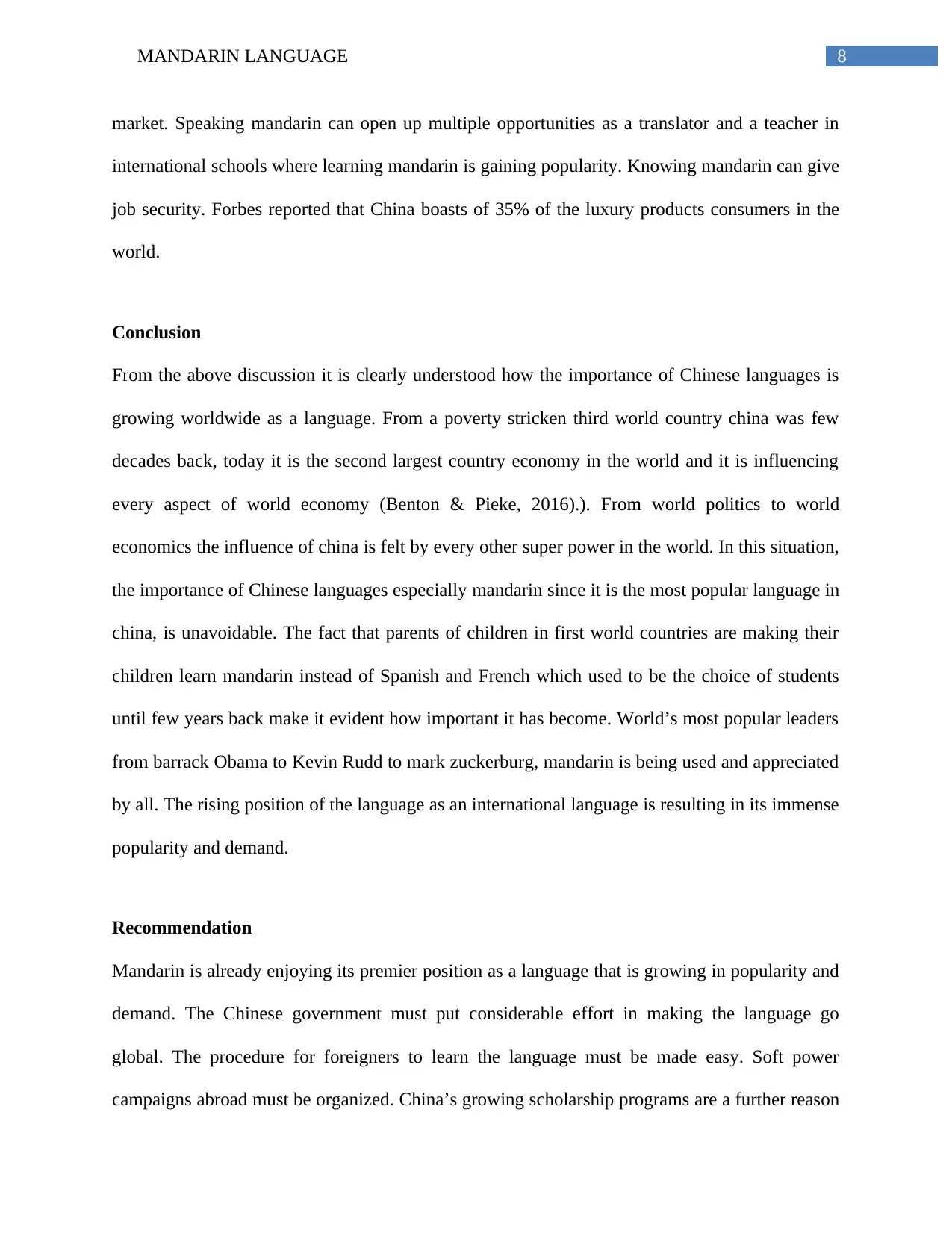
8MANDARIN LANGUAGE
market. Speaking mandarin can open up multiple opportunities as a translator and a teacher in
international schools where learning mandarin is gaining popularity. Knowing mandarin can give
job security. Forbes reported that China boasts of 35% of the luxury products consumers in the
world.
Conclusion
From the above discussion it is clearly understood how the importance of Chinese languages is
growing worldwide as a language. From a poverty stricken third world country china was few
decades back, today it is the second largest country economy in the world and it is influencing
every aspect of world economy (Benton & Pieke, 2016).). From world politics to world
economics the influence of china is felt by every other super power in the world. In this situation,
the importance of Chinese languages especially mandarin since it is the most popular language in
china, is unavoidable. The fact that parents of children in first world countries are making their
children learn mandarin instead of Spanish and French which used to be the choice of students
until few years back make it evident how important it has become. World’s most popular leaders
from barrack Obama to Kevin Rudd to mark zuckerburg, mandarin is being used and appreciated
by all. The rising position of the language as an international language is resulting in its immense
popularity and demand.
Recommendation
Mandarin is already enjoying its premier position as a language that is growing in popularity and
demand. The Chinese government must put considerable effort in making the language go
global. The procedure for foreigners to learn the language must be made easy. Soft power
campaigns abroad must be organized. China’s growing scholarship programs are a further reason
market. Speaking mandarin can open up multiple opportunities as a translator and a teacher in
international schools where learning mandarin is gaining popularity. Knowing mandarin can give
job security. Forbes reported that China boasts of 35% of the luxury products consumers in the
world.
Conclusion
From the above discussion it is clearly understood how the importance of Chinese languages is
growing worldwide as a language. From a poverty stricken third world country china was few
decades back, today it is the second largest country economy in the world and it is influencing
every aspect of world economy (Benton & Pieke, 2016).). From world politics to world
economics the influence of china is felt by every other super power in the world. In this situation,
the importance of Chinese languages especially mandarin since it is the most popular language in
china, is unavoidable. The fact that parents of children in first world countries are making their
children learn mandarin instead of Spanish and French which used to be the choice of students
until few years back make it evident how important it has become. World’s most popular leaders
from barrack Obama to Kevin Rudd to mark zuckerburg, mandarin is being used and appreciated
by all. The rising position of the language as an international language is resulting in its immense
popularity and demand.
Recommendation
Mandarin is already enjoying its premier position as a language that is growing in popularity and
demand. The Chinese government must put considerable effort in making the language go
global. The procedure for foreigners to learn the language must be made easy. Soft power
campaigns abroad must be organized. China’s growing scholarship programs are a further reason
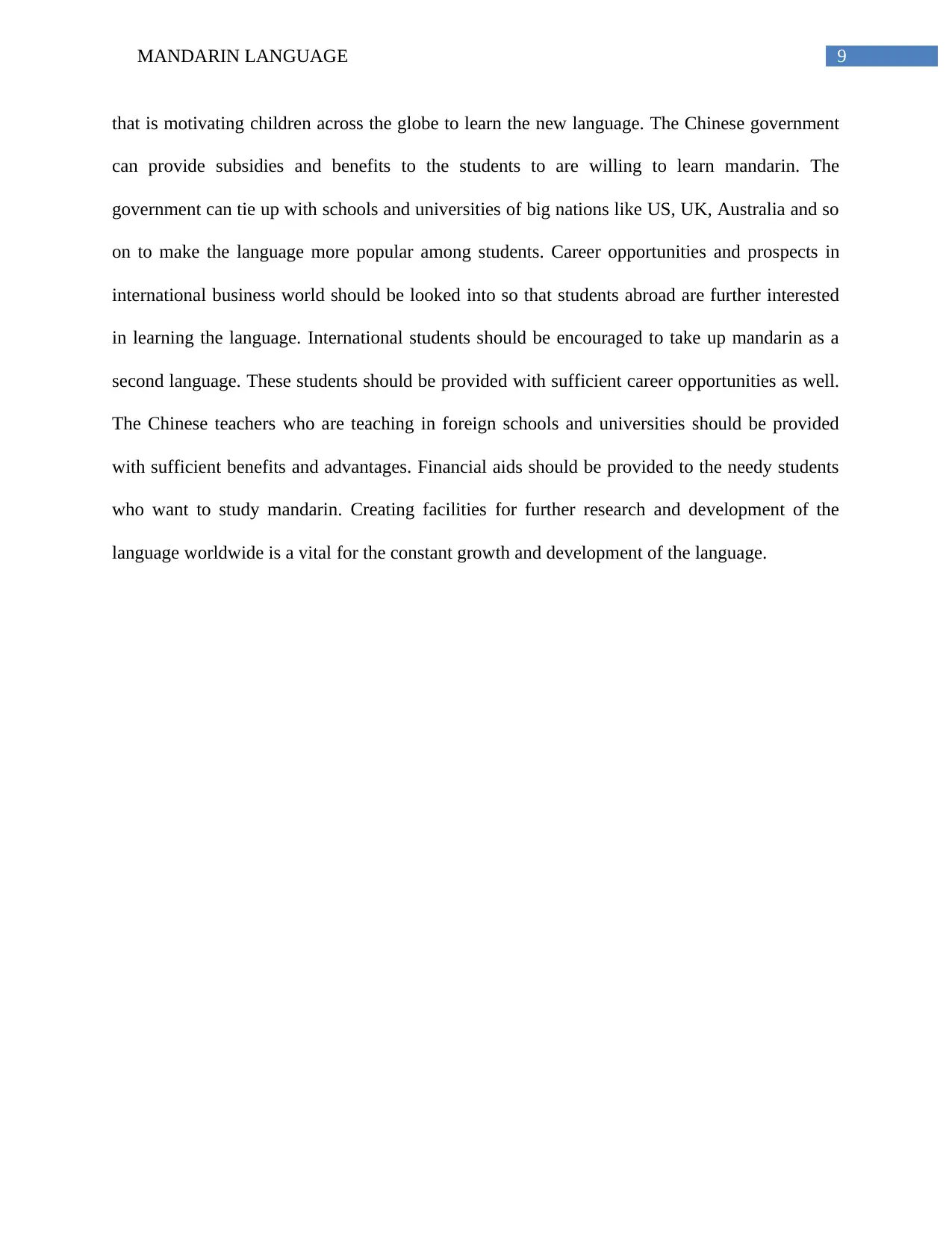
9MANDARIN LANGUAGE
that is motivating children across the globe to learn the new language. The Chinese government
can provide subsidies and benefits to the students to are willing to learn mandarin. The
government can tie up with schools and universities of big nations like US, UK, Australia and so
on to make the language more popular among students. Career opportunities and prospects in
international business world should be looked into so that students abroad are further interested
in learning the language. International students should be encouraged to take up mandarin as a
second language. These students should be provided with sufficient career opportunities as well.
The Chinese teachers who are teaching in foreign schools and universities should be provided
with sufficient benefits and advantages. Financial aids should be provided to the needy students
who want to study mandarin. Creating facilities for further research and development of the
language worldwide is a vital for the constant growth and development of the language.
that is motivating children across the globe to learn the new language. The Chinese government
can provide subsidies and benefits to the students to are willing to learn mandarin. The
government can tie up with schools and universities of big nations like US, UK, Australia and so
on to make the language more popular among students. Career opportunities and prospects in
international business world should be looked into so that students abroad are further interested
in learning the language. International students should be encouraged to take up mandarin as a
second language. These students should be provided with sufficient career opportunities as well.
The Chinese teachers who are teaching in foreign schools and universities should be provided
with sufficient benefits and advantages. Financial aids should be provided to the needy students
who want to study mandarin. Creating facilities for further research and development of the
language worldwide is a vital for the constant growth and development of the language.
Secure Best Marks with AI Grader
Need help grading? Try our AI Grader for instant feedback on your assignments.
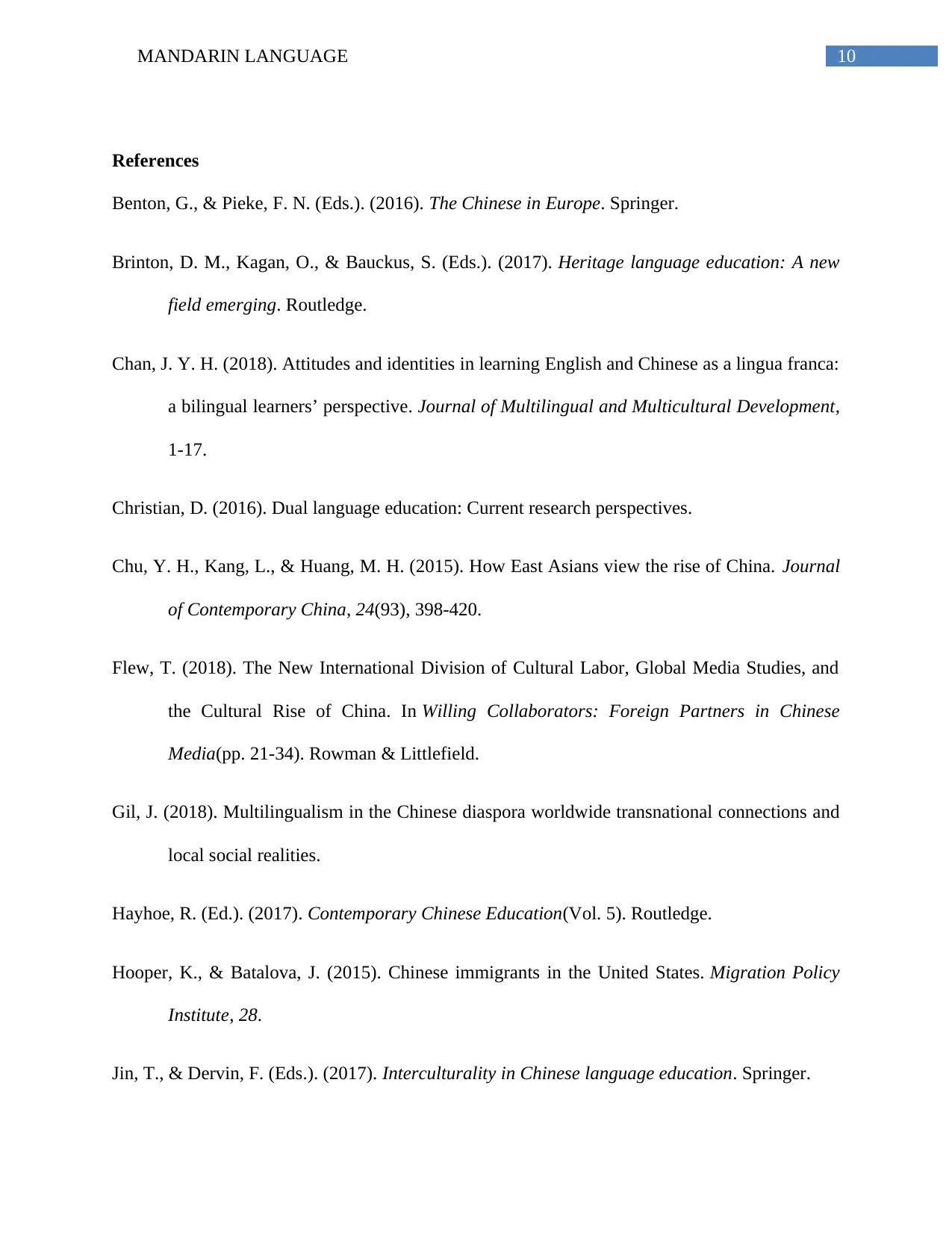
10MANDARIN LANGUAGE
References
Benton, G., & Pieke, F. N. (Eds.). (2016). The Chinese in Europe. Springer.
Brinton, D. M., Kagan, O., & Bauckus, S. (Eds.). (2017). Heritage language education: A new
field emerging. Routledge.
Chan, J. Y. H. (2018). Attitudes and identities in learning English and Chinese as a lingua franca:
a bilingual learners’ perspective. Journal of Multilingual and Multicultural Development,
1-17.
Christian, D. (2016). Dual language education: Current research perspectives.
Chu, Y. H., Kang, L., & Huang, M. H. (2015). How East Asians view the rise of China. Journal
of Contemporary China, 24(93), 398-420.
Flew, T. (2018). The New International Division of Cultural Labor, Global Media Studies, and
the Cultural Rise of China. In Willing Collaborators: Foreign Partners in Chinese
Media(pp. 21-34). Rowman & Littlefield.
Gil, J. (2018). Multilingualism in the Chinese diaspora worldwide transnational connections and
local social realities.
Hayhoe, R. (Ed.). (2017). Contemporary Chinese Education(Vol. 5). Routledge.
Hooper, K., & Batalova, J. (2015). Chinese immigrants in the United States. Migration Policy
Institute, 28.
Jin, T., & Dervin, F. (Eds.). (2017). Interculturality in Chinese language education. Springer.
References
Benton, G., & Pieke, F. N. (Eds.). (2016). The Chinese in Europe. Springer.
Brinton, D. M., Kagan, O., & Bauckus, S. (Eds.). (2017). Heritage language education: A new
field emerging. Routledge.
Chan, J. Y. H. (2018). Attitudes and identities in learning English and Chinese as a lingua franca:
a bilingual learners’ perspective. Journal of Multilingual and Multicultural Development,
1-17.
Christian, D. (2016). Dual language education: Current research perspectives.
Chu, Y. H., Kang, L., & Huang, M. H. (2015). How East Asians view the rise of China. Journal
of Contemporary China, 24(93), 398-420.
Flew, T. (2018). The New International Division of Cultural Labor, Global Media Studies, and
the Cultural Rise of China. In Willing Collaborators: Foreign Partners in Chinese
Media(pp. 21-34). Rowman & Littlefield.
Gil, J. (2018). Multilingualism in the Chinese diaspora worldwide transnational connections and
local social realities.
Hayhoe, R. (Ed.). (2017). Contemporary Chinese Education(Vol. 5). Routledge.
Hooper, K., & Batalova, J. (2015). Chinese immigrants in the United States. Migration Policy
Institute, 28.
Jin, T., & Dervin, F. (Eds.). (2017). Interculturality in Chinese language education. Springer.
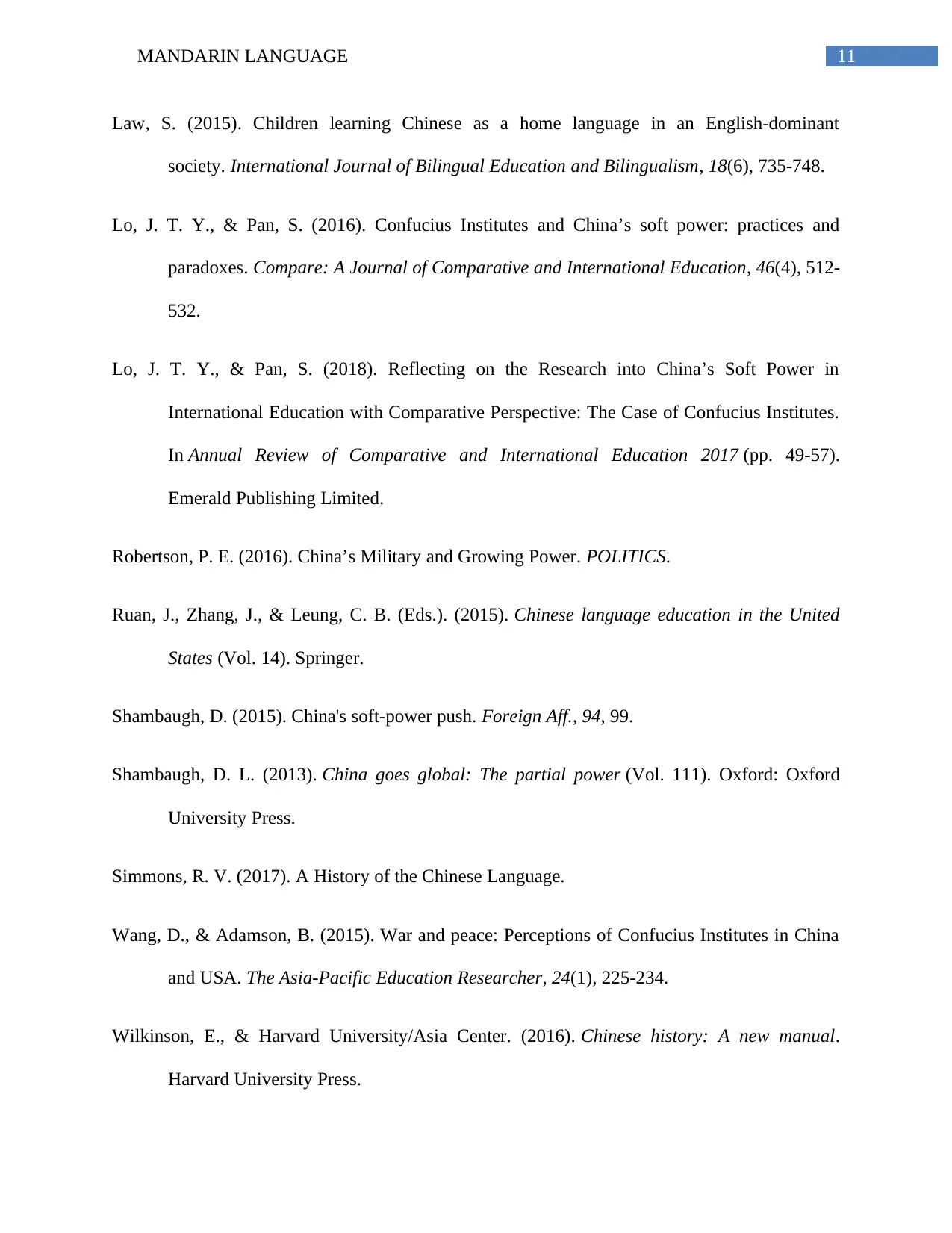
11MANDARIN LANGUAGE
Law, S. (2015). Children learning Chinese as a home language in an English-dominant
society. International Journal of Bilingual Education and Bilingualism, 18(6), 735-748.
Lo, J. T. Y., & Pan, S. (2016). Confucius Institutes and China’s soft power: practices and
paradoxes. Compare: A Journal of Comparative and International Education, 46(4), 512-
532.
Lo, J. T. Y., & Pan, S. (2018). Reflecting on the Research into China’s Soft Power in
International Education with Comparative Perspective: The Case of Confucius Institutes.
In Annual Review of Comparative and International Education 2017 (pp. 49-57).
Emerald Publishing Limited.
Robertson, P. E. (2016). China’s Military and Growing Power. POLITICS.
Ruan, J., Zhang, J., & Leung, C. B. (Eds.). (2015). Chinese language education in the United
States (Vol. 14). Springer.
Shambaugh, D. (2015). China's soft-power push. Foreign Aff., 94, 99.
Shambaugh, D. L. (2013). China goes global: The partial power (Vol. 111). Oxford: Oxford
University Press.
Simmons, R. V. (2017). A History of the Chinese Language.
Wang, D., & Adamson, B. (2015). War and peace: Perceptions of Confucius Institutes in China
and USA. The Asia-Pacific Education Researcher, 24(1), 225-234.
Wilkinson, E., & Harvard University/Asia Center. (2016). Chinese history: A new manual.
Harvard University Press.
Law, S. (2015). Children learning Chinese as a home language in an English-dominant
society. International Journal of Bilingual Education and Bilingualism, 18(6), 735-748.
Lo, J. T. Y., & Pan, S. (2016). Confucius Institutes and China’s soft power: practices and
paradoxes. Compare: A Journal of Comparative and International Education, 46(4), 512-
532.
Lo, J. T. Y., & Pan, S. (2018). Reflecting on the Research into China’s Soft Power in
International Education with Comparative Perspective: The Case of Confucius Institutes.
In Annual Review of Comparative and International Education 2017 (pp. 49-57).
Emerald Publishing Limited.
Robertson, P. E. (2016). China’s Military and Growing Power. POLITICS.
Ruan, J., Zhang, J., & Leung, C. B. (Eds.). (2015). Chinese language education in the United
States (Vol. 14). Springer.
Shambaugh, D. (2015). China's soft-power push. Foreign Aff., 94, 99.
Shambaugh, D. L. (2013). China goes global: The partial power (Vol. 111). Oxford: Oxford
University Press.
Simmons, R. V. (2017). A History of the Chinese Language.
Wang, D., & Adamson, B. (2015). War and peace: Perceptions of Confucius Institutes in China
and USA. The Asia-Pacific Education Researcher, 24(1), 225-234.
Wilkinson, E., & Harvard University/Asia Center. (2016). Chinese history: A new manual.
Harvard University Press.

12MANDARIN LANGUAGE
Yang, R. (2015). China's soft power projection in higher education. International Higher
Education, (46).
Yang, R. (2015). China's soft power projection in higher education. International Higher
Education, (46).
1 out of 13
Your All-in-One AI-Powered Toolkit for Academic Success.
+13062052269
info@desklib.com
Available 24*7 on WhatsApp / Email
![[object Object]](/_next/static/media/star-bottom.7253800d.svg)
Unlock your academic potential
© 2024 | Zucol Services PVT LTD | All rights reserved.


